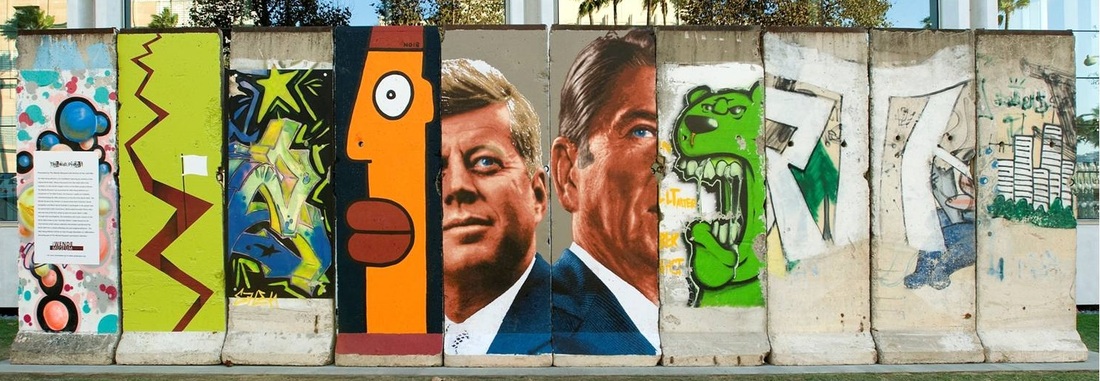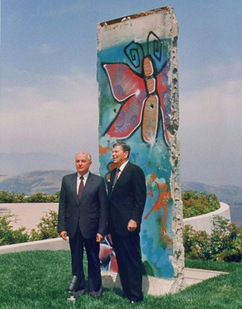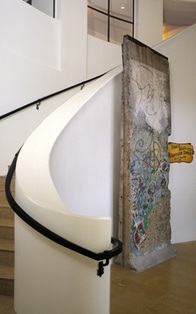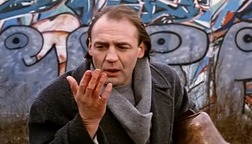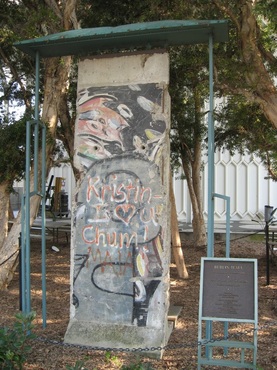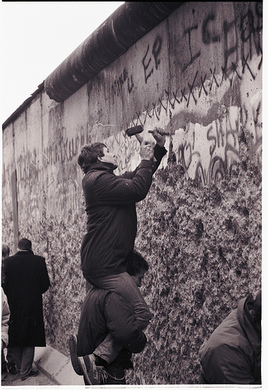 Wall with surface chiseled away.
Wall with surface chiseled away.
At the end of WWII, the previous center of Nazi-Germany, the city of Berlin, once again became the stage of world conflict as the U.S. and its allies quarreled with the Soviet Union and Communist Germans for domination of the city. The Berlin Wall was a barrier built by the German Democratic Republic that completely cut off West Berlin from East Berlin. The barrier included guard towers placed along large concrete walls. Construction of what would become the wall began on August 13th, 1961. The Eastern Bloc claimed that the wall was erected to protect its population from fascist elements, but it also prevented massive defection. Along with the Inner German border, the Berlin Wall came to symbolize the "Iron Curtain" that separated Western Europe and the Eastern Bloc during the Cold War.
Beginning in August of 1961, the border between West and East Berlin was closed off with barbed wire and fencing. These preliminary measures were later replaced by pieces of concrete slabs as defectors continued to breach the meager fortifications. In all, there were actually four versions of the wall over its lifetime, the fourth being the most iconic. The most generally accepted date of the “Fall of the Berlin Wall” is November 9th, 1989. Its actual deconstruction took several years as borders were opened to the people.
Almost immediately, and for some time after, people began using sledgehammers to demolish parts of the wall to create unofficial border crossings. Others used chisels to chip off souvenirs. Since the fall, “official souvenir” companies have sold pieces of the wall around the world. The total length of the wall at the time of its fall is estimated at 96 miles, with an average height of about 12 feet (up to 25 feet in certain sections). With plenty of wall to go around, collecting pieces for prosperity quickly became a common occurrence. Over the years, many universities and museums have collected the more substantial pieces of the Berlin Wall for display. Surprisingly, Los Angeles and its surrounding areas have become home to several outstanding examples of the Berlin Wall.
Beginning in August of 1961, the border between West and East Berlin was closed off with barbed wire and fencing. These preliminary measures were later replaced by pieces of concrete slabs as defectors continued to breach the meager fortifications. In all, there were actually four versions of the wall over its lifetime, the fourth being the most iconic. The most generally accepted date of the “Fall of the Berlin Wall” is November 9th, 1989. Its actual deconstruction took several years as borders were opened to the people.
Almost immediately, and for some time after, people began using sledgehammers to demolish parts of the wall to create unofficial border crossings. Others used chisels to chip off souvenirs. Since the fall, “official souvenir” companies have sold pieces of the wall around the world. The total length of the wall at the time of its fall is estimated at 96 miles, with an average height of about 12 feet (up to 25 feet in certain sections). With plenty of wall to go around, collecting pieces for prosperity quickly became a common occurrence. Over the years, many universities and museums have collected the more substantial pieces of the Berlin Wall for display. Surprisingly, Los Angeles and its surrounding areas have become home to several outstanding examples of the Berlin Wall.
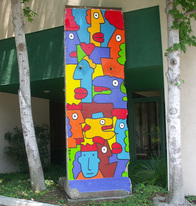
The Wende Museum and Archive of the Cold War (Culver City, California).
The Wende Museum and Archive of the Cold War features a wall segment that stands at the Museum's entrance, which was painted by the French-born, Berlin-based artist Thierry Noir.
The museum also owns the longest stretch of the wall outside of Berlin, which is located in front of the Variety Building at 5900 Wilshire Boulevard. Both pieces are currently on display and accessible to the public.
The Wende Museum and Archive of the Cold War features a wall segment that stands at the Museum's entrance, which was painted by the French-born, Berlin-based artist Thierry Noir.
The museum also owns the longest stretch of the wall outside of Berlin, which is located in front of the Variety Building at 5900 Wilshire Boulevard. Both pieces are currently on display and accessible to the public.
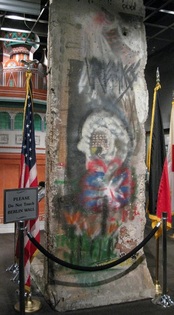
Richard Nixon Presidential Library & Birthplace
(Yorba Linda, California).
A segment of the Berlin Wall is located inside the museum area of the Richard Nixon Library & Birthplace in Yorba Linda, California. It was dedicated on the 31st anniversary of the Berlin Wall's construction. Located just south of Los Angeles, The Nixon Library's segment of the wall is 12 feet high, and is on display in the expansive foreign affairs gallery. The wall serves visitors of the museum as a symbol of the many duties undertaken during Nixon's Presidency, and Vice-Presidency as well. As VP to the Eisenhower Administration, Nixon was a key figure in foreign affairs early in the development of the Cold War. He even went head-to-head with Soviet Premier Nikita Khrushchev in the famous "Conversation in the Kitchen".
(Yorba Linda, California).
A segment of the Berlin Wall is located inside the museum area of the Richard Nixon Library & Birthplace in Yorba Linda, California. It was dedicated on the 31st anniversary of the Berlin Wall's construction. Located just south of Los Angeles, The Nixon Library's segment of the wall is 12 feet high, and is on display in the expansive foreign affairs gallery. The wall serves visitors of the museum as a symbol of the many duties undertaken during Nixon's Presidency, and Vice-Presidency as well. As VP to the Eisenhower Administration, Nixon was a key figure in foreign affairs early in the development of the Cold War. He even went head-to-head with Soviet Premier Nikita Khrushchev in the famous "Conversation in the Kitchen".
|
Loyola Marymount University (Los Angeles, California).
A segment of the Berlin Wall is kept on the main campus of Loyola Marymount University. LMU was the only university in the world to receive a section of the Berlin Wall from the City of Berlin. The section was dedicated in 1997, and features artwork by Thierry Noir as well. Part of the original mural can be seen in the German film “Wings of Desire” (1987). |
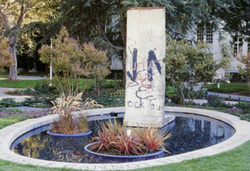
Chapman University (Orange, California).
Chapman University displays the second largest piece of the Berlin Wall owned by an American university on its main campus. The landscaped display of the wall section is located in Liberty Plaza. University President, Jim Doti, negotiated and planned for three years for the university to receive a segment of the wall. A ring surrounding the wall segment quotes Abraham Lincoln, “A house divided against itself cannot stand.”
Chapman University displays the second largest piece of the Berlin Wall owned by an American university on its main campus. The landscaped display of the wall section is located in Liberty Plaza. University President, Jim Doti, negotiated and planned for three years for the university to receive a segment of the wall. A ring surrounding the wall segment quotes Abraham Lincoln, “A house divided against itself cannot stand.”

